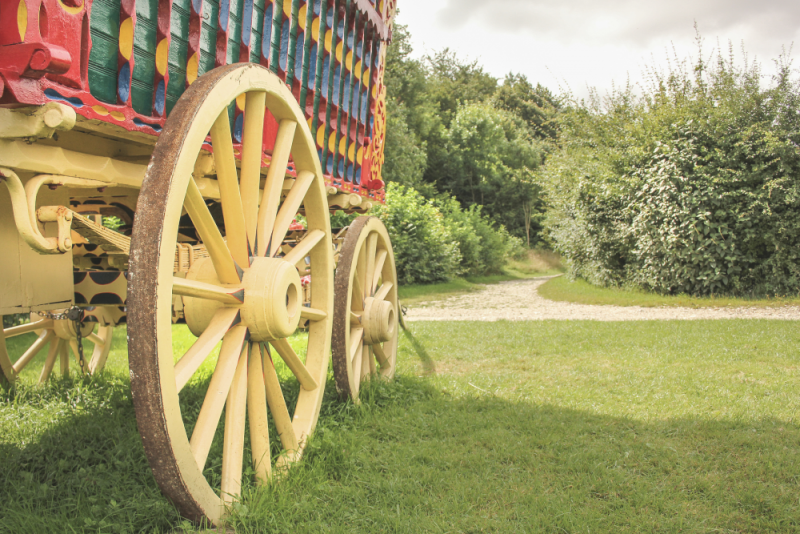Gypsy, Roma and Traveller pupils are statistically the most vulnerable of any identified group of pupils in the UK. Why is this, and what can be done in schools to challenge biases and change mindsets?

Damian Le Bas’ book The Stopping Places: A journey through Gypsy Britain, which combines memoir with a story of the British traveller community, is a beautifully told and elegantly crafted work about Gypsy culture. It explains misconceptions and counters stereotypes, shining light on a world that many of us do not fully encounter or understand.
It is an affecting book; it compels the reader to find out more. It sent me on an online voyage of discovery through numerous fascinating videos. Animated histories of Gypsy, Roma and Traveller people tell of persecution and discrimination; literary panel discussions explore language, culture and the social exclusion of this misunderstood community; and arts events showcase poetry, song art and literature with beauty and solidarity.
Katharine Quarmby, author of No Place to Call Home: Inside the real lives of Gypsies and Travellers, speaks of the need for neutral reporting on the traveller community, and Damian Le Bas counters misconceptions, calmly and studiously explaining what is not widely known about this ethnic group.
All of this is on offer, freely available to anyone with a laptop and internet connection. Many films contextualizing, explaining, educating and illuminating (see the resources list further below for some suggestions). Yet the inequalities faced by Gypsy, Roma and Traveller communities are immense, and the casual yet harmful discrimination they face seems to be resistant to measures to address it.
Entrenched prejudices are seemingly impossible to shift and the notion that this is a homogeneous "problem social group" still persists, even among some educators. As a 2009 Equality and Human Rights Commission Report stated, 'Racism towards most ethnic minority groups is now hidden, less frequently expressed in public, and widely seen as unacceptable. However, that towards Gypsies and Travellers is still common, frequently overt and seen as justified.'
Tragically for community cohesion, the years since 2009 have seen a marked rise in racist incidents, in particular since the 2016 referendum on membership of the European Union, and this is also reflected in societal attitudes to those seen as outsiders.
The knock-on effect of this is deeply troubling. According to the 2019 Women and Equalities Commission Report, Tackling inequalities faced by Gypsy, Roma and Traveller communities, Gypsy, Roma and Traveller people have ‘the worst outcomes of any ethnic group across a huge range of areas, including education, health, employment, criminal justice and hate crime’.
Historically, every modern EU state has had anti-gypsy laws at some point and the Women and Equalities Commission Report states that: ‘In the sixteenth Century a law was passed in England that allowed the state to imprison, execute or banish anyone that was perceived to be a Gypsy’. Around one quarter of the Roma population in Europe was exterminated by the Nazis in the Gypsy Holocaust.
It is little wonder that the Gypsy, Roma and Traveller community feels the effects of this history, and suffers as the vestiges of persecution persist to this day.
The 2011 Census recorded 58,000 people who self-identified as Gypsy, Traveller in England and Wales, but this could be a significant underestimate. It is thought that this figure may be closer to 100-300,000 Gypsy, Traveller people and up to 200,000 Roma people in the UK. While many now live in settled housing, some are nomadic.
Gypsy, Roma and Traveller children face myriad issues accessing education and consequently have 'the lowest attainment of all ethnic groups throughout their school years'. (Tackling inequalities faced by Gypsy, Roma and Traveller communities).
One of the recommendations in the 2019 report is that ‘schools should, as part of their responsibilities under the Public Sector Equality Duty, be challenging race and gender stereotypes whenever they encounter them’. It goes on to say that ‘schools have responsibilities to support and educate young Roma people. Internal and informal exclusions of Roma children should not be used as a mechanism to improve exclusion rates. Ofsted should actively inspect schools for signs of Roma students being internally or informally excluded.'
While there are clearly areas that schools and their wider communities can focus on to target the structures that might be preventing Gypsy, Roma and Traveller children from achieving their full potential, schools can also explore ways of improving inclusion. These ideas may help.
Looking at the latest reports into the educational experiences of children from Gypsy, Roma and Traveller families, it is clear that there is work to do to improve relationships, banish racism and stereotypes, and help children and young people to access what they need in order to thrive in school. This is something we can all work towards.